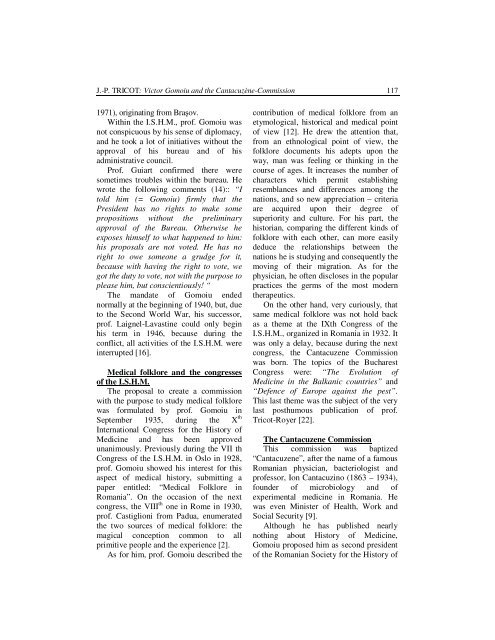Series VI: Medical Sciences – SUPPLEMENT ... - Krongres
Series VI: Medical Sciences – SUPPLEMENT ... - Krongres
Series VI: Medical Sciences – SUPPLEMENT ... - Krongres
You also want an ePaper? Increase the reach of your titles
YUMPU automatically turns print PDFs into web optimized ePapers that Google loves.
J.-P. TRICOT: Victor Gomoiu and the Cantacuzène-Commission 117<br />
1971), originating from Bra�ov.<br />
Within the I.S.H.M., prof. Gomoiu was<br />
not conspicuous by his sense of diplomacy,<br />
and he took a lot of initiatives without the<br />
approval of his bureau and of his<br />
administrative council.<br />
Prof. Guiart confirmed there were<br />
sometimes troubles within the bureau. He<br />
wrote the following comments (14):: “I<br />
told him (= Gomoiu) firmly that the<br />
President has no rights to make some<br />
propositions without the preliminary<br />
approval of the Bureau. Otherwise he<br />
exposes himself to what happened to him:<br />
his proposals are not voted. He has no<br />
right to owe someone a grudge for it,<br />
because with having the right to vote, we<br />
got the duty to vote, not with the purpose to<br />
please him, but conscientiously! “<br />
The mandate of Gomoiu ended<br />
normally at the beginning of 1940, but, due<br />
to the Second World War, his successor,<br />
prof. Laignel-Lavastine could only begin<br />
his term in 1946, because during the<br />
conflict, all activities of the I.S.H.M. were<br />
interrupted [16].<br />
<strong>Medical</strong> folklore and the congresses<br />
of the I.S.H.M.<br />
The proposal to create a commission<br />
with the purpose to study medical folklore<br />
was formulated by prof. Gomoiu in<br />
September 1935, during the X th<br />
International Congress for the History of<br />
Medicine and has been approved<br />
unanimously. Previously during the <strong>VI</strong>I th<br />
Congress of the I.S.H.M. in Oslo in 1928,<br />
prof. Gomoiu showed his interest for this<br />
aspect of medical history, submitting a<br />
paper entitled: “<strong>Medical</strong> Folklore in<br />
Romania”. On the occasion of the next<br />
congress, the <strong>VI</strong>II th one in Rome in 1930,<br />
prof. Castiglioni from Padua, enumerated<br />
the two sources of medical folklore: the<br />
magical conception common to all<br />
primitive people and the experience [2].<br />
As for him, prof. Gomoiu described the<br />
contribution of medical folklore from an<br />
etymological, historical and medical point<br />
of view [12]. He drew the attention that,<br />
from an ethnological point of view, the<br />
folklore documents his adepts upon the<br />
way, man was feeling or thinking in the<br />
course of ages. It increases the number of<br />
characters which permit establishing<br />
resemblances and differences among the<br />
nations, and so new appreciation <strong>–</strong> criteria<br />
are acquired upon their degree of<br />
superiority and culture. For his part, the<br />
historian, comparing the different kinds of<br />
folklore with each other, can more easily<br />
deduce the relationships between the<br />
nations he is studying and consequently the<br />
moving of their migration. As for the<br />
physician, he often discloses in the popular<br />
practices the germs of the most modern<br />
therapeutics.<br />
On the other hand, very curiously, that<br />
same medical folklore was not hold back<br />
as a theme at the IXth Congress of the<br />
I.S.H.M., organized in Romania in 1932. It<br />
was only a delay, because during the next<br />
congress, the Cantacuzene Commission<br />
was born. The topics of the Bucharest<br />
Congress were: “The Evolution of<br />
Medicine in the Balkanic countries” and<br />
“Defence of Europe against the pest”.<br />
This last theme was the subject of the very<br />
last posthumous publication of prof.<br />
Tricot-Royer [22].<br />
The Cantacuzene Commission<br />
This commission was baptized<br />
“Cantacuzene”, after the name of a famous<br />
Romanian physician, bacteriologist and<br />
professor, Ion Cantacuzino (1863 <strong>–</strong> 1934),<br />
founder of microbiology and of<br />
experimental medicine in Romania. He<br />
was even Minister of Health, Work and<br />
Social Security [9].<br />
Although he has published nearly<br />
nothing about History of Medicine,<br />
Gomoiu proposed him as second president<br />
of the Romanian Society for the History of


